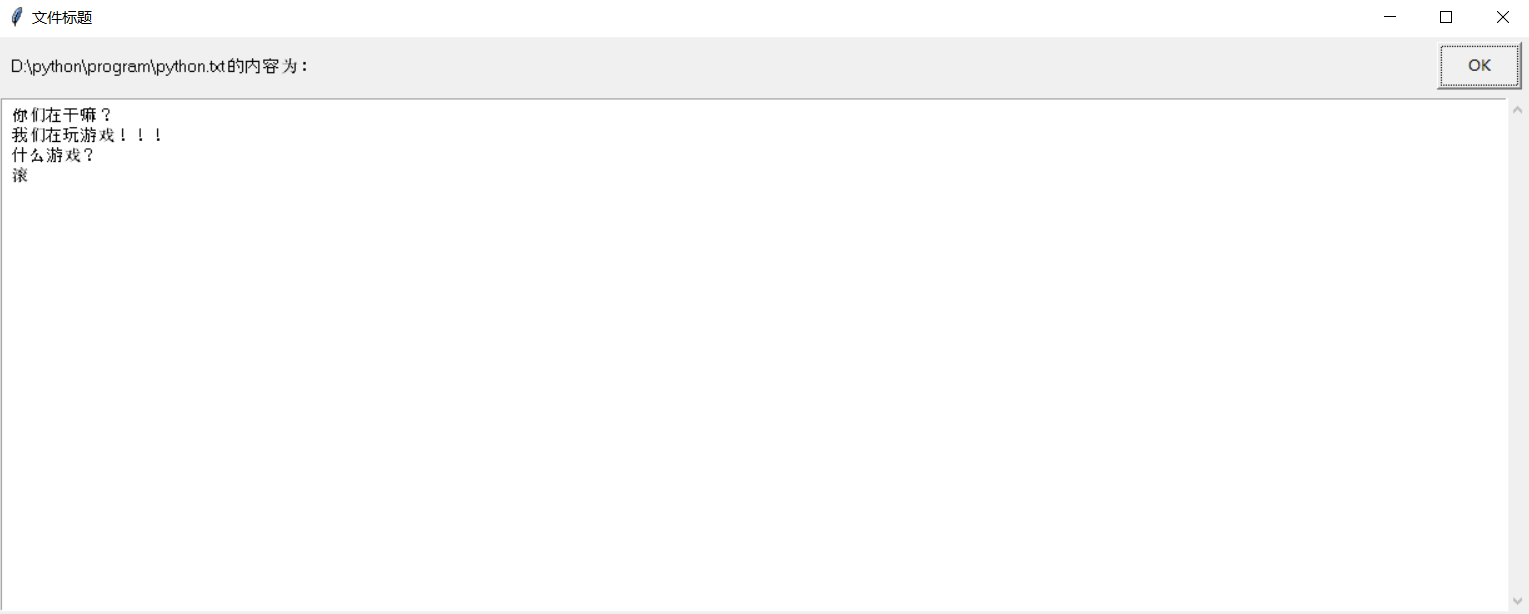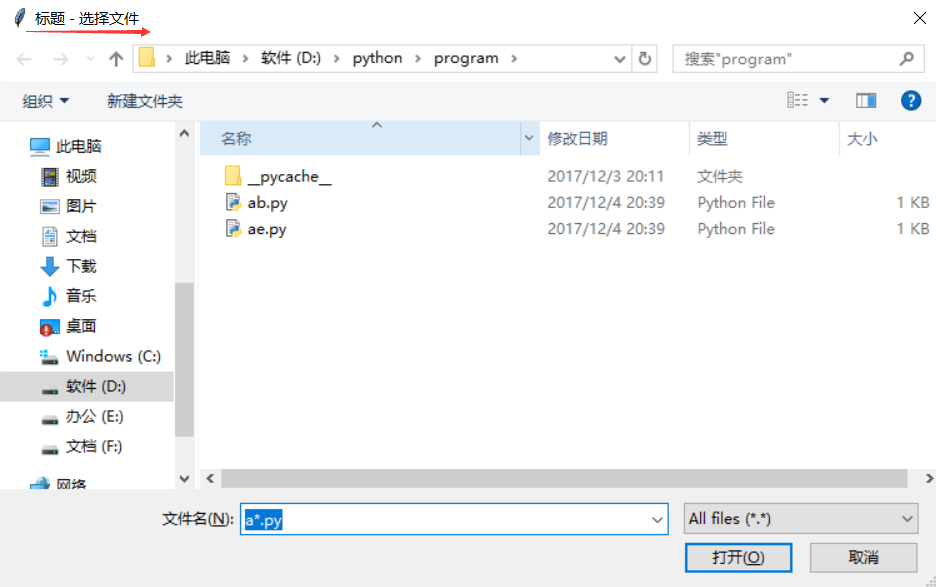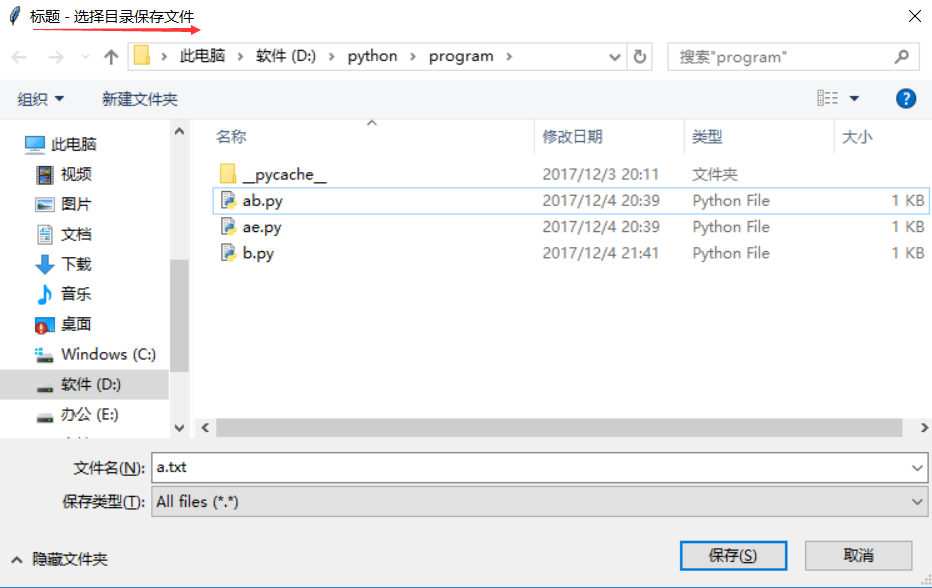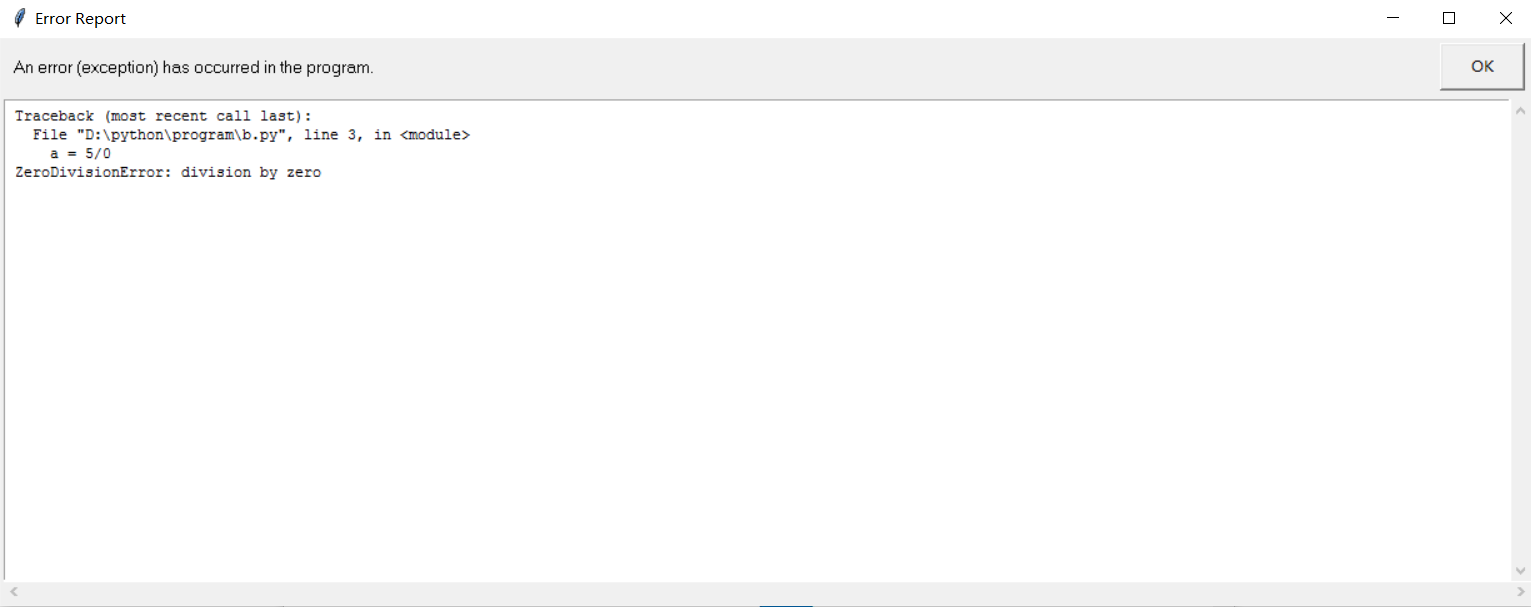1.输入密码
1.passwordbox的使用 passwordbox(msg, title,default=’默认的密码’, image=None)
1 2 3 4 5 6
| import easygui as g def passwordbox(msg, title): msg = g.passwordbox(msg, title,default='默认的密码', image=None) print(msg) passwordbox('content', 'title')
|

2.multpasswordbox的使用multpasswordbox(msg, title, fields, values)
1 2 3 4 5 6 7 8
| import easygui as g def multpasswordbox(msg, title, fields, values): msg = g.multpasswordbox(msg, title, fields, values) print(msg) # ['张三', '123456'] fields = ('用户名','密码') values = ('张三', '123456') multpasswordbox('输入密码', '标题', fields, values)
|
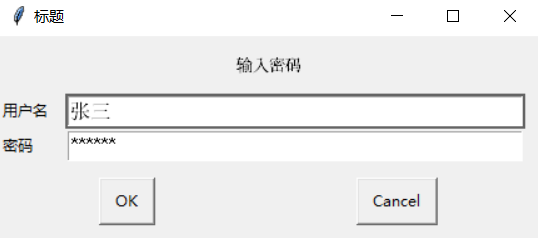
2.显示文本
1 2 3 4 5 6 7 8 9 10 11 12 13 14 15 16 17 18 19 20 21 22 23 24 25 26 27
| import easygui as g import os def readfileshoutext(): boxtitle = '选择文件' boxcontent = '读取文件内容' filepath = g.fileopenbox(boxcontent, boxtitle,default = 'D:/*.txt',filetypes='[*.txt]') file = open(filepath) filetext = file.read() texttitle = '文件标题' texttip = filepath + ' 的内容为:' boxtext = g.textbox(texttip,texttitle,text=filetext,codebox=0) if filetext != boxtext[:-1]: btn = ('覆盖保存','放弃保存','另存为...') choice = g.buttonbox('文件内容发生改变了,请选择如下操作:','警告',btn) if choice == '覆盖保存': with open(filepath,'w') as oldfile: oldfile.write(boxtext[:-1]) oldfile.close() if choice == '放弃保存': pass if choice == '另存为...': newfilepath = g.filesavebox(default='.txt') newfile = open(newfilepath,'w') newfile.write(boxtext[:-1]) newfile.close() readfileshoutext()
|
改变文件弹出选择

3.目录与文件
1.diropenbox选择目录的路径 diropenbox(msg, title, default = None)
1 2 3 4 5 6
| import easygui as g def diropenbox(msg, title): msg = g.diropenbox(msg, title, default = None) print(msg) diropenbox('目录', '标题')
|
2.fileopenbox 选择文件的路径 fileopenbox(msg, title, default = ‘*’,filetypes = None)
default = ‘D:/python/program/a.py’ 表示D盘program下以a开头.py结尾的所有文件
default = ‘ * ‘ 表示所有文件
filetypes = [‘*.py’] 显示以.py结尾的文件
filetypes = None 显示所有文件
1 2 3 4 5 6
| import easygui as g def fileopenbox(msg, title): msg = g.fileopenbox(msg, title, default = '*',filetypes = None) print(msg) fileopenbox('选择文件', '标题')
|
3.filesavebox 选择保存文件的路径 filesavebox(msg, title, default = filename,filetypes = None)
default 文件的名字
1 2 3 4 5 6 7 8 9 10
| import easygui as g def filesavebox(filetext, filename, msg, title): filepath = g.filesavebox(msg, title, default = filename,filetypes = None) filecontent = open(filepath,'w') filecontent.write(filetext) filecontent.close() print(filepath) filename = 'a.txt' filetext = '这是一个测试文件的内容' filesavebox(filetext,filename, '选择目录保存文件', '标题')
|
4.保存设置数据
有个小问题,读出来的是个啥??待了解
1 2 3 4 5 6 7 8 9 10 11 12 13 14 15 16
| import os from easygui import * class Settings(EgStore): def __init__(para,filename): para.user = '' para.age = '' para.filename = filename para.restore() settings = Settings('D:/seting.txt') settings.user = '张三' settings.age = str(20) settings.store()
a = open('D:/seting.txt','rb') print(a.read())
|
5.界面显示异常
1 2 3 4 5
| import easygui as g try: a = 5/0 except: g.exceptionbox()
|
6.选择某一个目录统计代码行数
1 2 3 4 5 6 7 8 9 10 11 12 13 14 15 16 17 18 19 20 21 22 23 24 25 26 27 28 29 30 31 32 33 34 35 36 37 38 39 40 41 42 43 44 45 46 47 48 49 50 51 52 53
| import easygui as g import os def show(path): lines = 0 total = 0 text = '' for i in soft_list: lines = soft_list[i] total += lines text += '[%s]源文件%d个,源代码%d行\n'%(i,file_list[i],lines) text += '它们分别为:\n' for key,value in countdict.items(): text += key + '的代码为%s行' % value + '\n' title = '统计结果' msg = '目前共%d行代码!' % total g.textbox(msg,title,text) def calc_code(file): lines = 0 f = open(file,'r',encoding = 'utf-8') print('正在计算:%s' % file) lines = len(f.readlines()) return lines def search_file(file_dir): os.chdir(file_dir) #改变当前工作目录到指定的路径 for item in os.listdir(os.curdir): ftype = os.path.splitext(item)[1] # 得到文件后缀名 if ftype in filetype: lines = calc_code(item) try: file_list[ftype] +=1 except: file_list[ftype] = 1 #统计代码行数 try: soft_list[ftype] += lines except: soft_list[ftype] = lines countdict.setdefault(item,lines) if os.path.isdir(item): search_file(item) # 递归 os.chdir(os.pardir) # 返回上一层目录 filetype = ['.py','.xml','.java'] file_list = {} soft_list = {} countdict = {} path = g.diropenbox('选择要统计的代码文件:') # 文件路径 search_file(path) show(path)
|



